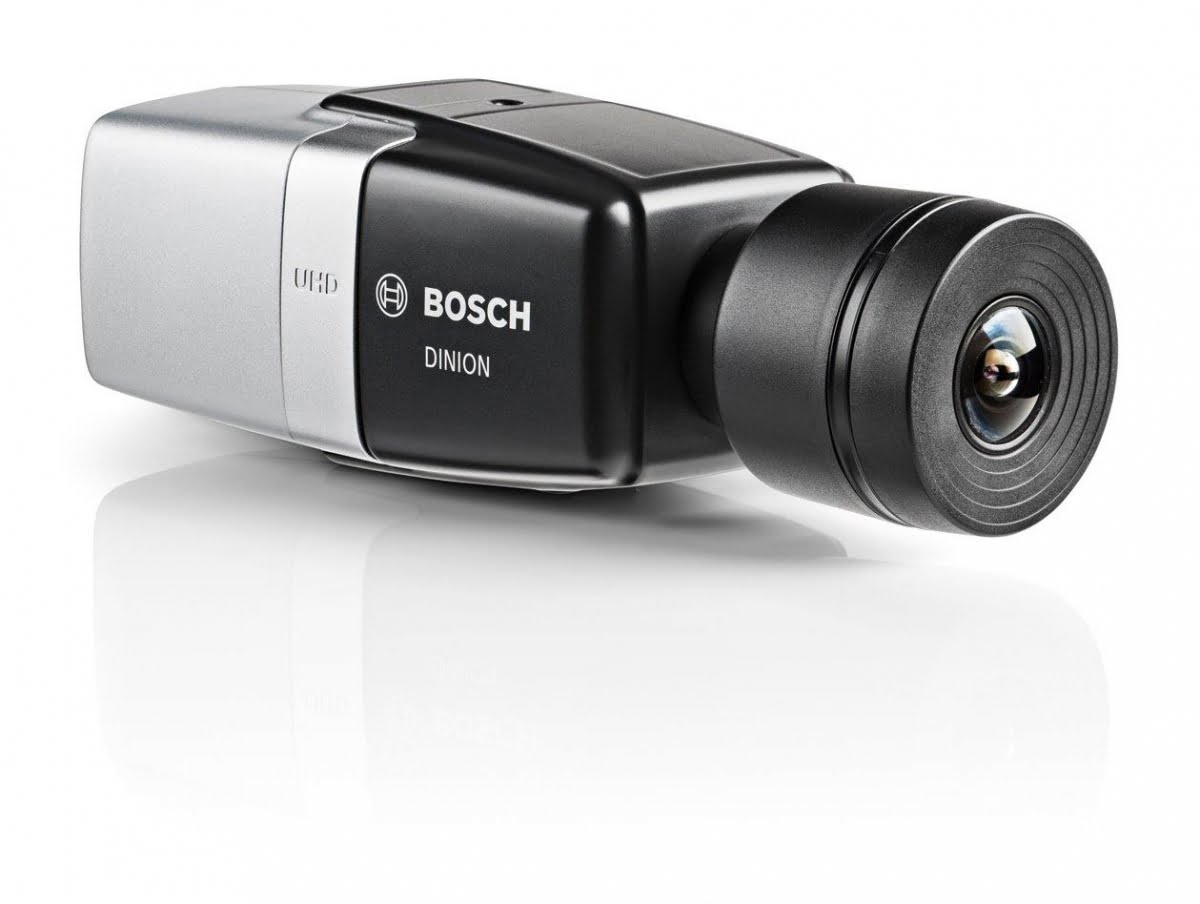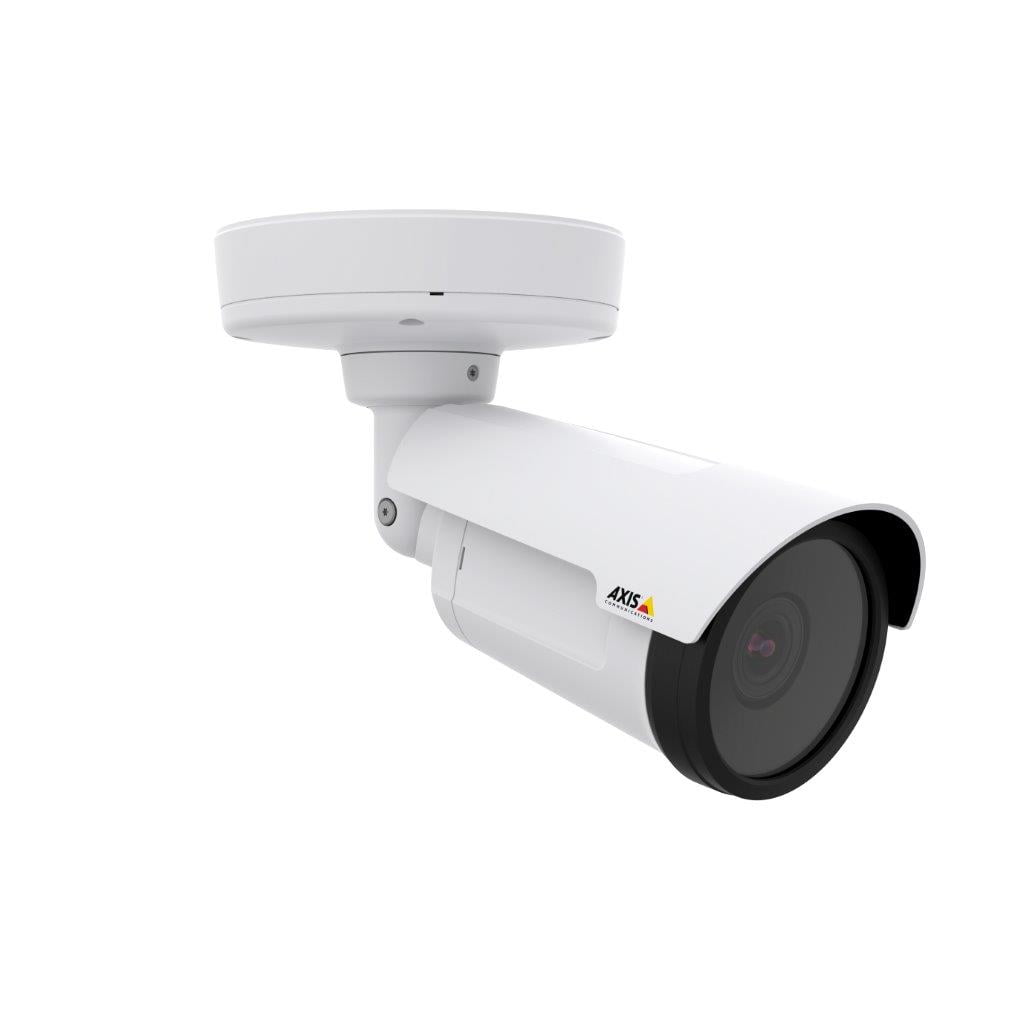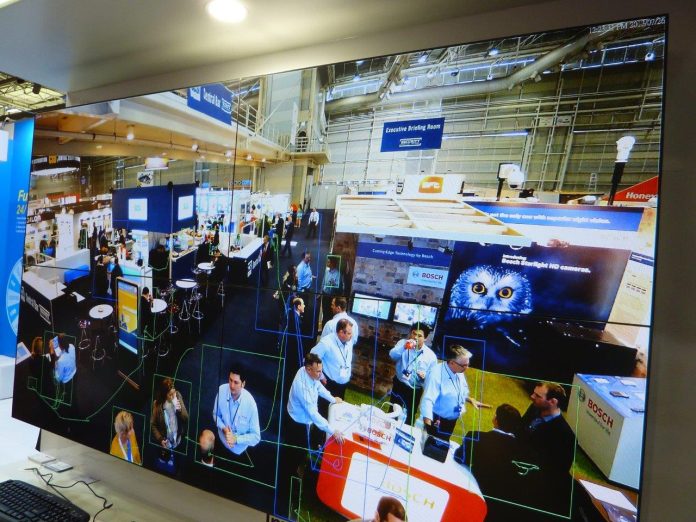It looks like the next benchmark for video surveillance cameras is going to be the Ultra HD standard, with a resolution of 3840 x 2160 – around 8MP. Given the challenges networks may face carrying Ultra HD video streams it’s hard to say just when we will see the technology reach a tipping point.
THERE are a couple of signs worth paying attention to with Ultra HD (commonly called 4K in consumer and CCTV industries). The first is that UHD consumer monitors are now dropping in price at a time many homeowners’ first 1080p HD monitors may be starting to look a little tired. Something else to bear in mind is the consensus forming in digital photography that 8MP is the sweet spot that allows the best balance of low light performance and high resolution.
As most readers know, the more pixels you cram onto an imager, the smaller those pixels must be. And the smaller the pixels, the less light they can absorb. Double the number of pixels on a 1/3-inch HD sensor and you halve the light reaching the sensor. The result is that more pixels does not a perfect camera make – not unless sensor sizes increase. If it’s all about display images today, then 3MP cameras with a 1080p resolution are ideal. When it comes to 4K, adequate light is the key – at least 25 lux is required to hold colour and hold off excesses of motion blur.
But if you have sufficient light, need digital zoom or you use a UHD monitor, then Ultra HD cameras, especially those with the latest BSI technology sensors, should be a consideration. If you zoom in 2x digital with an Ultra HD image then you are viewing at 2MP, which is pretty good considering how quickly it takes an HD camera to burrow down under 4CIF when digital zoom is applied.
Something else to bear in mind when considering digital image quality is that pixels on a digital camera’s sensor capture light in red, blue or green – not all colours at once. A layout will be a pair of green, a red and a blue in a grid pattern and onboard software then nuts out the colour value for pixels. This means there’s signal attenuating averaging going on in the background – one colour per 4 pixels.
A camera’s digital engine is also working hard to stave off false colours and moire – spacial aliasing that causes false patterns in a scene. Camera engines will blur an image slightly then sharpen it in order to lose such artifacts. Clearly, the more pixels, the more work the camera processor has to get through and this can be noticeable as latency or blurring if there’s sudden movement – like cars moving at right angles across a scene.
Lenses are another issue. An Ultra HD camera is going to need a quality lens and there’s no doubt that plenty of 1080p cameras are being sold with lenses that are not perfect. Sure, things look good in the centre of the image but out towards the edges details get muddy, especially when applying the sorts of deep digital zooms that might motivate a buyer to choose Ultra HD in the first place.
Sensor noise is also something that has to be considered at multiple levels. In low light, cameras increase exposure, elevating noise levels. Furthermore, pixel measurements are never perfect and the flaws in these signals show up on a monitor as noise. It’s unhelpful during the day and blinding at night. Digital noise reduction is the answer but DNR processing doesn’t just lose noise, it sloughs fine detail off a scene. When you look at a camera being tested in low light you can often see the areas where DNR has scrubbed and smudged a scene free of detail. It’s not a good look.
Engineers can build high resolution imagers with fewer noise problems but they need to be big – 1-inch or 1/1.5 inch sensors are ideal. A 1/1.5-inch sensor has 4x the area of the 1/3-inch sensors that typically run inside 1080p CCTV cameras. No wonder GBO’s S1080 camera (BGWT sells them in Australia) with its monster 1-inch sensor has such a great image in low light.
If the sensors are large enough, the lenses are good enough, the light levels high enough, the network is capable enough and the storage sufficient, then Ultra HD cameras will give end users a lot more detail than 3MP 1080p cameras can. But this capability has to be balanced against many things. Image quality is about more than megapixel count.

Vlado Damjanovski
Not surprisingly, ViDi Labs, Vlado Damjanovski, takes 2 positions when it comes to whether or not Ultra HD cameras will be the next big thing in CCTV applications.
“My answer is yes and no,” says Damjanovski. “4K is a known development in broadcast TV but CCTV is only a little sister of broadcast technology, and eventually follows its trends. But unless the technology trend is developed by the larger broadcast industry, it’s very unlikely CCTV will develop a whole new standard on its own. So yes, it is the next big thing, but not so big as some may want to think.”
When it comes to the advantages and disadvantages of Ultra HD cameras Damjanovski is emphatic.
“The advantage is obvious – enhanced resolution and more details,” he says. “But this can only be valid if the optics are of matching quality. Weaknesses? If a sensor is of the similar size as the equivalent HD sensor and it has 4x the pixels – low light performance will be 4x lower. And streaming bandwidth will be close to 4x larger unless better compression is used.”
“If a sensor is of the similar size as the equivalent HD sensor and it has 4x the pixels – low light performance will be 4x lower. And streaming bandwidth will be close to 4x larger unless better compression is used”
According to Damjanovski, while it’s important for CCTV applications that Ultra HD monitors display very high quality images in real time, there are other considerations.
“You need to have a 4K monitor to see such an advancement, and faster computers with more processing power to decode the 4k streaming.”

Given there are already 5MP and 9MP cameras from various manufacturers that are not widely used, end users might well ask what makes Ultra HD different? Is it that use of the technology in consumer TV market will change user expectation of what a high resolution image is? Why not just go with big MP cameras?
“The first and important difference with 5MP or 9MP is that when these cameras were introduced there were no real time encoders available – only MJPEG image compression was possible,” Damjanovski explains. “With 4K becoming a mainstream broadcast format, encoder chips capable of real-time video compression became available. But, again, don’t forget this requires more processing power at the displaying end which would typically performs software decoding, as well as digital zooming.”
Something SEN often sees is systems that run 1080p cameras at 720p and 6-15 frames per second, presumably because end users don’t want to spend too big on network storage. If 1080p is not being used entirely, it’s tempting to think this underlying fundamental means Ultra HD is unlikely to be leveraged in many applications either.
“If H264 compression is used for 1080HD or 720HD, there is not much difference in the network requirement if the frame rate is 6, or 15 or 25 frames,” says Damjanovski. “The real difference might be in picture quality of moving objects which may increase the bandwidth if one wants to keep the quality. So yes, the same reasoning applies to 4k format. It will definitely require more bandwidth. But, we will soon see implementation of H265, which is only new, but it claims saving on bandwidth for at least 50 per cent by preserving the picture quality.”
So – how far does Damjanovski think are we away from Ultra HD as a common CCTV resolution in the way 1080p resolutions are today?
“Broadcast people are already using 4K for their daily production,” Damjanovski says. “There’s even an Australian company that makes very affordable but excellent quality 4K cameras for video production (BlackMagic Design). But broadcast people make money with their production and they don’t shy from spending money for the best results.
“How far is CCTV away from 4K? As always – it will depend on the cost and not only cost of the cameras. Solutions will needs suitable optics, encoders, transmission, recorders and faster computers and most importantly, 4K displays to enjoy the glory of more pixels.
“My experience is that end users in CCTV don’t want to spend money to achieve better quality for the sake of quality,” says Damjanovski. “They are only willing to spend money if it can save them losses by reducing shrinkage, or if they have to satisfy some legal security requirement.
“Maybe 5 years down the track, 4K may become as standard as HD today, and then everybody in CCTV will have no choice but to use 4K. Progress will not stop in developing 4K, although CCTV is not the driving force – that comes from the broadcast TV and consumer markets.”

Steve Charles of Sony Australia
Sony released a 4K concept CCTV camera at the recent ISC West show in Las Vegas. While it’s still early days, Sony’s Steve Charles says further development will address issues before the company releases its first 4K camera.
Charles believes 4K will definitely be the next big thing in the consumer and CCTV markets. In CCTV he says one 4K monitor can display 4×4 scaled D1-size image which is very effective for viewing multiple cameras. And like Damjanovski, Charles pairs 4K with H.265 to get over some of the challenges the technology faces in real world applications.
“Yes absolutely – it will be big,” he says. “Obviously, there are advantages and disadvantages of 4K technology. A major advantage is the extended picture resolution and ability to reduce the number of cameras normally used in open spaces.
“The major disadvantage is the bandwidth required for high resolution, although H.265 will address this issue somewhat. Low light capabilities are also restricted by pixel sizes and the amount of light that falls onto an imager. Wide Dynamic range is also an issue.”
What makes 4K different from bigger megapixel cameras and more likely to meet widespread acceptance? Charles explains that 4K is different from the megapixel still image format.
“4K is a video standard format of 16:9, whereas megapixel is a still image format of 4:3,” he says. “Something else to consider is what’s effective for the customer’s operational or total system cost. When 5MP and 9MP were launched; sensitivity, wide dynamic range, compression and HDD cost did not suit customer requirements. These situations are gradually changing today.”
According to Charles, 4K systems will need to be carefully planned so that the most use can be made of its higher resolutions. He says system design must be seriously considered and fit for purpose. How far are we away from Ultra HD as a common resolution in the way 1080p resolutions are today, according to Charles?
“Full HD has only recently become the dominant format in security applications but that wasn’t the case only 2 years ago,” Charles says. “Already 4K has people’s attention and is not so far away given technology changes. However, it will depend on improvements/developments in 4K devices and additional key technologies.”

Bosch’s Steve Malesevic
Steve Malesevic at Bosch also believes 4K will be a big thing in the consumer market and this will spill over into the CCTV industry.
“People always want more – bigger resolution, more storage,” he says. “If some is good then more is better – it’s just human nature – so it makes sense that 4K will become huge in the consumer and then the CCTV markets.”
For Malesevic, the strengths and weaknesses of the 4K are more detail and fewer cameras (reduced installation cost) on the strength side and high storage costs and increased bandwidth being weaknesses. In Malesevic’s opinion, in 12-18 months 4K will be fairly common. And he points out that the driving force of 4K may be marketing, or market demand.
“Perhaps it will come down to something non-technical like marketing,” he explains. “Regular consumers understand words like ultra, high and definition. They understand that these words are associated with positive attributes. However, they may not necessarily understand what is meant by words like megapixel. It may end up being good marketing that really opens applications up to 4K.
“Added to this, manufacturers that can introduce technologies that can significantly reduce bandwidth at the camera (even with Ultra HD resolutions) will start to make the changes in expectations in a positive fashion.”
While Malesevic agrees some 1080p applications are not being used to their maximum capacity, he says a number of factors might be different with 4K.
“Firstly, early adopters will embrace the new technology and make the required spending on storage to cover the higher data rates from the cameras,” he says.
“Secondly, if people don’t want to spend more on storage now, they’ll inevitably reduce the IPS on Ultra HD cameras to meet their storage capacity. Only after storage becomes more affordable will they increase the IPS, improving their viewing experience.”

Wai King Wong of Axis Communications
At Axis Communications, Wai King Wong also feels 4K has a big future.
“4K-compliant cameras are definitely set to become one of the major milestones when it comes to the evolution of IP surveillance,” he says. “How widely 4K is utilized will largely depend on factors which make up an IP surveillance system such as compression algorithms, storage capacity, network bandwidth and the ability to cope with challenging lighting conditions.”
For Wong, the big advantage of UHD cameras is definitely resolution.
“However similar to the comparison between 2MP and 1080p HDTV, it’s not just about throwing a greater number of pixels into the image but also being able to achieve a certain level of benchmarks when it comes to frame rate and colour representation.
“Factors to keep in mind when it comes to 4K cameras are that the increase in resolution will also push up bandwidth and storage requirements. Additional lighting may also be required as the camera is designed to use smaller pixels on the sensor, there will be more noise which will limit the light sensitivity and may reduce the dynamic range.”
Something else Wong likes about 4K is that it is a quality standard, not an expression of pixel resolution as megapixel is.
“Just as for HDTV 720p, 1080i or 1080p, the main difference is that HDTV/4K are international technology standards for image quality, whereas megapixel refers only to the exact pixel resolution of a camera,” Wong says. “An HDTV/4K network camera that complies with any of the given HDTV/4K standards ensures video quality. Megapixel doesn’t define a set frame rate as the HDTV and 4K standards do.”
Something else Wong likes about 4K is its ability to support high quality live view, even it users choose not to store images at full frame rate.
“While it’s true that for most security based applications there are no requirements to record at full frame rate due to storage concerns, most users will run Live View at full frame rate allowing for smoother motion that’s more pleasing to the eye,” he says. “A 4K camera is capable of delivering this high resolution live stream for monitoring but it does not in any way increase storage requirements.”
How far are we away from Ultra HD as a common resolution, according to Wong?
“If we look back to 2009 we will see that numerous things happened during that time frame,” says Wong. “HDTV standard compliant cameras from Axis were first introduced, H.264 encoding became more commonly utilized over MPEG-4 and average network infrastructure got better. 1Gbit networks started becoming the standard.
“In many ways, in order for 4K or Ultra HD IP cameras to become common, other aspects of the IP surveillance ecosystem will need to evolve along with them. Perhaps H.265 will become the next component in this ever progressing evolution.”
By John Adams
Related stories:
Is 4K Suitable for Security Applications?
“An HDTV/4K network camera that complies with any of the given HDTV/4K standards ensures video quality. Megapixel doesn’t define a set frame rate as the HDTV and 4K standards do”










